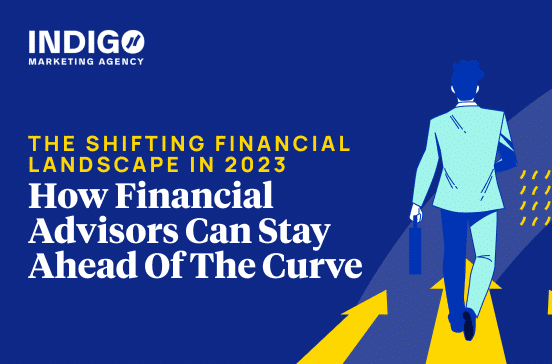
Can you believe we’re halfway through 2023? Looking back to the beginning of the year, the financial headlines spelled a near-certain disaster. Between persistent inflation, rising interest rates, bank failures, and a looming recession, financial advisors across the country have had their hands full with uncertainty and fear. But is that still the case going forward? Let’s take a look at the shifting landscape for financial advisors and how marketing can play an important role in the second half of 2023.
And stay tuned til the end to claim your free blog post to send to your clients!
What Happened to the Recession?
While the financial landscape at the beginning of 2023 looked rather bleak, there are signs that the economy is turning around—specifically when it comes to the long-predicted recession. Strong job growth and a pause in interest rate hikes have experts revising their initial predictions.
In May, the U.S. job market grew by 339,000 new jobs, which was much higher than anticipated and more than any single month of job growth in 2019. Consistent gains in the job market over the last several months combined with low unemployment has many experts believing that the once-certain recession is becoming increasingly unlikely.
In another sign that things are turning around, the Federal Reserve has stopped raising interest rates after 15 months of consecutive hikes. The Federal Reserve may slightly raise rates later this year, but it isn’t expected to be raised as dramatically as it was during 2022. Inflation, most recently 4% as of May, has slowed since reaching a peak of 9.1% last year. The decision to pause rates will give the Fed time to assess whether further rate hikes are needed. We’re certainly not out of the woods yet, but there is hope on the horizon that the second half of 2023 will be brighter than initially predicted.
Looking Forward
The stock market has seen a surge of optimism as well with the S&P 500 reaching bull market status on June 9th. The index has rebounded 23% since its low in October 2022, causing the Chief Equity Strategist at Bank of America, Savita Subramanian, to announce, “The bear market is officially over.”
So what can financial advisors expect from the second half of 2023? Increasing interest in AI stocks and the technology of the future. Interestingly, most of the S&P 500 rebound has been driven by gains in the tech sector as seasoned investors and everyday consumers are flocking to technology (see: NVDA) to stay ahead of the curve.
Focus on Engagement
Despite the shift in the financial landscape, many Americans believe we are currently experiencing a recession. According to a recent survey from TransUnion, 44% of Americans believe we are either already in a recession or will be by the end of June 2023, regardless of the ongoing optimism in job growth, interest rate hikes, and stock market performance.
Our best advice for dealing with this gap between economic data and consumer perception is to focus on client engagement through marketing. Considering 3 of the biggest reasons why clients leave a financial advisor are communication related, marketing and other timely communications are a crucial element of client retention in a shifting financial landscape. Take a look at the graph below from a Spectrem Group study to learn more.
As the financial landscape for the second half of 2023 continues to develop, here are 5 steps financial advisors can take to improve client engagement and retention through proactive marketing:
1. Build Trust in Uncertain Times
During periods of economic uncertainty, trust becomes an invaluable asset for financial advisors. Clients rely on you to provide guidance and stability amidst fluctuating markets and confusing financial indicators.
Prioritize client communication even when times are uncertain. Don’t hesitate to put out content that addresses ongoing market events (think: SVB collapse, debt ceiling crisis). Though economic and market events change rapidly, keeping your clients informed can build and strengthen their trust in you as an advisor and reinforce the value of your services. (Hint: Working with an expert marketing team can make keeping up with current events much easier!)
2. Provide Personalized Guidance
Uncertain times also call for tailored strategies that address clients’ unique financial situations and goals. Engage with clients through personalized marketing that addresses their specific needs and concerns in the context of the current financial landscape. It’s one thing to post generic stats about ongoing recession fears or market volatility, but it’s another thing entirely to provide concrete examples of how your target audience can prepare for a recession or weather an economic storm. See some examples below:
- What size emergency fund is appropriate for your average client?
- If you work with clients in a particular sector, what does the landscape look like? Are there layoffs coming or a change in management? How can clients prepare for this possibility?
- Are your clients retired and disproportionately affected by persistent inflation? What are specific strategies to alleviate this risk?
This level of individualized attention demonstrates a commitment to the client’s financial well-being and helps create a sense of partnership, instilling confidence even in the face of economic uncertainty.
3. Anticipate and Adapt to Changing Client Needs
During periods of potential recession or high inflation, clients’ financial priorities and goals may shift. By fostering client engagement, financial advisors can stay attuned to these changing needs and adapt their strategies accordingly. Regular check-ins with email and content marketing can open up conversations and allow advisors to proactively address concerns, provide updated information, and adjust recommendations to align with clients’ evolving circumstances. This adaptability demonstrates a client-centric approach and reinforces your value in guiding clients through uncertain times.
4. Empower Clients With Education
Just like uncertainty can negatively affect the stock market, it often breeds financial anxiety and confusion among clients. By prioritizing client engagement through marketing, financial advisors can empower their clients with knowledge and education. Host webinars, post blogs, videos, or other educational content discussing market trends, potential risks, and investment strategies to help clients understand the rationale behind recommendations and make better informed decisions. By acting as a reliable source of information and providing ongoing education, you can position yourself as a trusted advisor and help clients navigate through periods of economic uncertainty.
5. Strengthen Client Relationships for Long-Term Success
Client engagement is not a short-term tactic but a long-term strategy for financial advisor success. By consistently engaging with clients, advisors can develop strong, lasting relationships that extend beyond specific market conditions. During uncertain times, clients are more likely to stick with advisors they trust and feel connected to, which can help weather challenging market conditions and even lead to referrals and new business opportunities. By focusing on engagement and nurturing client relationships, you can establish a solid foundation for long-term success and growth.

Stay Ahead of the Curve With an All-Weather Marketing Strategy
It’s easy to stay connected when everything is going well. But to succeed in a changing financial landscape, financial advisors must have a consistent, reliable, and high-quality marketing strategy in good times and in bad.
At Indigo Marketing Agency, we help financial advisors stay competitive with impactful messaging through every economic outlook. The second half of 2023 may be on an upswing, but will your marketing keep up? Schedule your free consultation today to receive personalized recommendations about how you can stay ahead of the curve.
BONUS: If you book your free call, you’ll get a free blog post on this topic to send out to your clients. I call that a win-win!
































